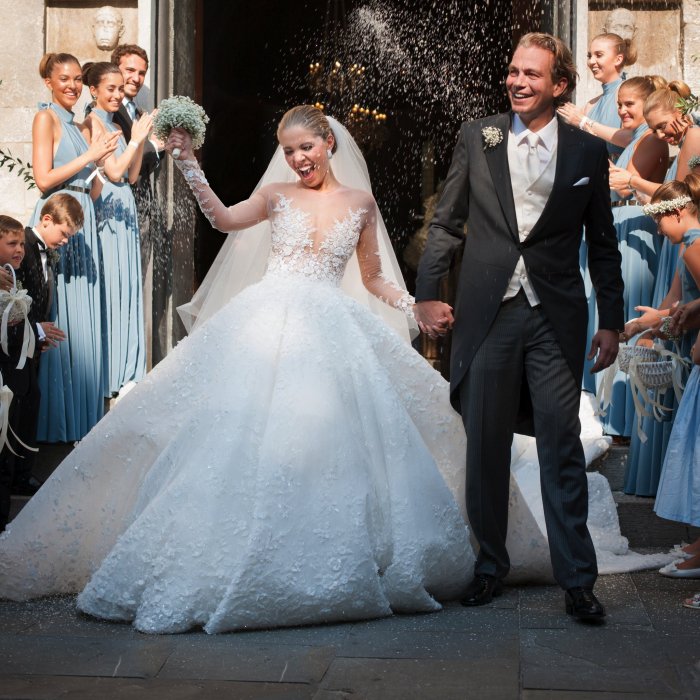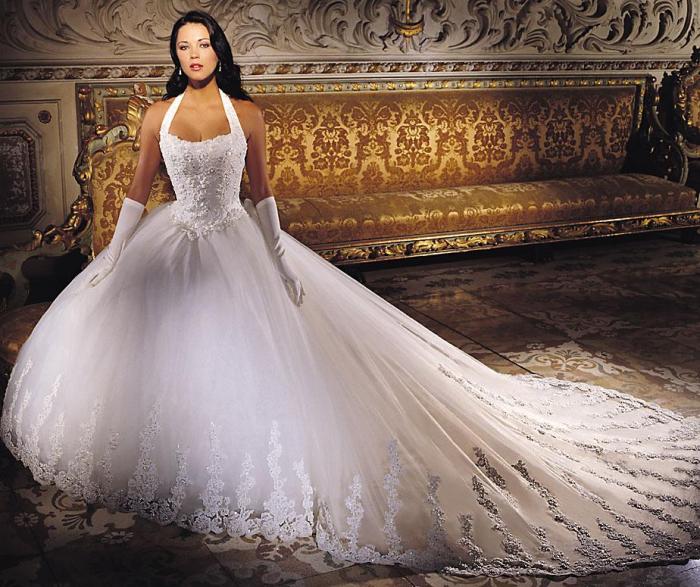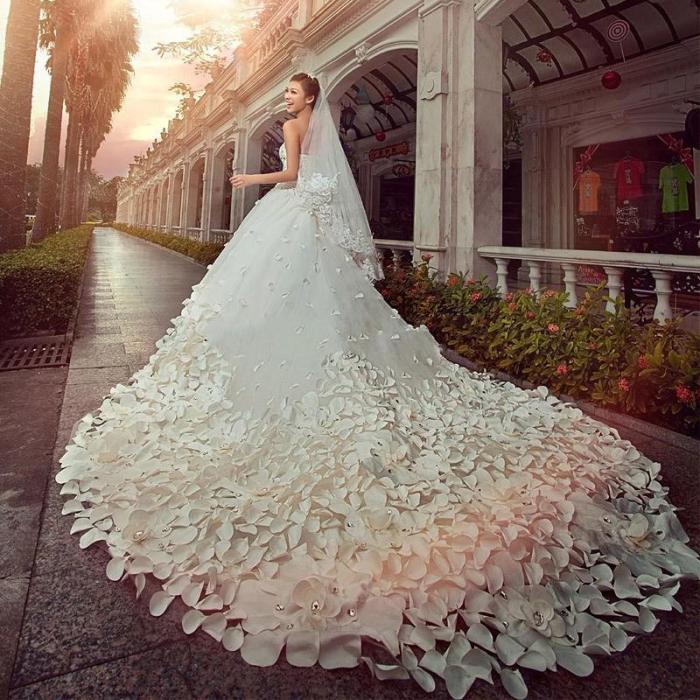Defining “Most Expensive” in Wedding Dresses
The most expensive wedding dress – The term “most expensive wedding dress” is inherently subjective. While a dress’s price tag provides a quantifiable measure, the true value is a complex interplay of several factors, going beyond simple monetary worth. Understanding these factors is crucial to appreciating the cost of truly luxurious bridal gowns.
Factors Contributing to a Wedding Dress’s Cost
Several elements contribute significantly to a wedding dress’s price. High-quality materials, such as hand-embroidered silk, intricate lace, and precious gemstones, significantly inflate the cost. The level of craftsmanship, involving hours of meticulous hand-stitching, beading, or appliqué, also plays a crucial role. The designer’s reputation and brand recognition are major factors, with established luxury houses commanding premium prices.
Finally, the design’s uniqueness and complexity, including intricate detailing and bespoke elements, can dramatically increase the overall price.
Perceived Value Versus Actual Cost

Source: weddedwonderland.com
The perceived value of a wedding dress often surpasses its actual production cost. Factors such as brand prestige, exclusivity, and the emotional significance associated with a wedding contribute to this discrepancy. A dress from a renowned designer might command a higher price than one of similar quality from a lesser-known maker, reflecting the brand’s perceived value and the associated marketing and branding efforts.
Pricing Strategies of High-End Wedding Dress Designers
High-end designers employ various pricing strategies to justify their high prices. These strategies include emphasizing the use of exclusive, high-quality materials, highlighting the intricate craftsmanship involved, leveraging the designer’s reputation and brand heritage, and creating a sense of exclusivity through limited production runs or bespoke designs. Ultimately, the pricing reflects the perceived value and desirability of the dress within the target market.
Historical Context of Expensive Wedding Dresses
The evolution of wedding dress design and the increasing prominence of luxury bridal wear are deeply intertwined with socio-cultural shifts. From simple, practical garments to the elaborate creations we see today, the journey reflects changing attitudes towards marriage, fashion, and societal status.
Evolution of Wedding Dress Design and the Rise of Luxury

Source: financesonline.com
Historically, wedding dresses varied significantly across cultures and time periods. The modern concept of a lavish, white wedding dress emerged relatively recently. The increasing affluence of certain segments of society and the rise of haute couture in the 19th and 20th centuries contributed to the development of increasingly extravagant and expensive bridal attire. This trend has continued, with designers constantly pushing the boundaries of luxury and innovation.
Historically Significant Expensive Wedding Dresses
Several historically significant wedding dresses exemplify the evolution of luxury bridal wear. Grace Kelly’s iconic wedding gown, for example, set a new standard for elegance and sophistication. The intricate details and luxurious materials used in the dress cemented its place in bridal fashion history. Similarly, many royal weddings have showcased extravagant and expensive dresses, solidifying the link between luxury and high-profile events.
Timeline of Increasing Wedding Dress Costs
While precise cost data across centuries is challenging to obtain, a general trend of increasing prices is evident. A timeline could show a gradual increase in average wedding dress costs throughout the 20th and 21st centuries, correlating with economic growth and changing societal values. Significant spikes in cost could be linked to specific landmark weddings or shifts in fashion trends.
Materials and Craftsmanship in High-End Wedding Dresses
The luxurious materials and meticulous craftsmanship employed in high-end wedding dresses are fundamental to their high cost. The selection of fabrics, embellishments, and the dedication to handmade details all significantly impact the final price.
Expensive Fabrics Used in High-End Wedding Dresses
The most expensive fabrics used often include rare silks, such as hand-woven silk brocade or vintage silk, and delicate, hand-made laces. These materials are costly due to the labor-intensive production methods, the rarity of the materials themselves, and the expertise required to work with them.
Intricate Techniques and Hand-Crafted Elements
Intricate hand-crafted elements, such as beading, embroidery, and appliqué, add significantly to the cost and the overall aesthetic appeal of the dress. Hours of meticulous work by skilled artisans are often involved, driving up the price. These handcrafted details demonstrate the dedication to quality and artistry that characterizes high-end bridal wear.
Comparison of Fabrics and Their Impact on Price
| Fabric | Cost Impact | Description | Examples of Use |
|---|---|---|---|
| Silk | High | Luxurious, smooth texture; varies widely in price depending on type and origin (e.g., silk charmeuse, silk organza). | Bodice, skirt, lining |
| Lace | High to Moderate | Intricate patterns; cost varies depending on the type of lace (e.g., Chantilly, Alençon, Venetian). Hand-made lace is significantly more expensive than machine-made. | Veil, bodice overlay, sleeves |
| Pearls | High | Adds elegance and sophistication; cost depends on the size, quality, and type of pearls (e.g., freshwater, Akoya, South Sea). | Embellishments, beading, appliqué |
| Tulle | Moderate | Lightweight, sheer fabric; often used for layering and creating volume. | Skirt underskirt, veil |
Famous Designers and Their Creations
Several renowned designers are celebrated for their high-priced wedding dress creations. Their distinct design philosophies and aesthetic approaches contribute to the unique character and value of their work.
Descriptions of Famous Wedding Dress Designers
Vera Wang is known for her dramatic, often minimalist designs with intricate details. Elie Saab creates romantic and ethereal gowns, often featuring delicate lace and embellishments. Zuhair Murad is celebrated for his glamorous and opulent designs, often incorporating intricate beading and luxurious fabrics.
While the most expensive wedding dress ever sold commanded a staggering price, the beauty of a wedding gown often lies in its cultural significance. For instance, the vibrant and intricate designs of mexican dresses for wedding offer a captivating alternative, showcasing rich heritage and tradition. Ultimately, the value of a wedding dress transcends mere cost, reflecting personal style and cultural identity, even when compared to the most lavish creations.
Comparison of Design Philosophies
While all three designers create luxury gowns, their design philosophies differ. Vera Wang often emphasizes clean lines and modern silhouettes, while Elie Saab favors romantic and flowing styles. Zuhair Murad focuses on opulence and glamour, incorporating rich embellishments and luxurious fabrics.
List of the Most Expensive Wedding Dresses
- Designer: [Designer Name], Year: [Year], Notable Features: [Description]
- Designer: [Designer Name], Year: [Year], Notable Features: [Description]
- Designer: [Designer Name], Year: [Year], Notable Features: [Description]
The Impact of Celebrity Weddings
Celebrity weddings significantly influence the perception and pricing of high-end wedding dresses. The media’s coverage of these events amplifies the visibility of specific designers and styles, shaping public opinion and driving demand.
Celebrity Wedding Dresses Setting New Standards, The most expensive wedding dress
Celebrity weddings often showcase extravagant and expensive dresses, setting new standards for luxury bridal wear. The media’s extensive coverage of these events increases the visibility of specific designers and styles, influencing public perception and driving demand for similar designs. This, in turn, can impact pricing, as designers capitalize on the increased demand for their creations.
Media’s Role in Shaping Public Opinion
The media plays a crucial role in shaping public opinion on the cost of wedding dresses. Extensive coverage of celebrity weddings, fashion magazines, and social media platforms contribute to a perception that expensive dresses are synonymous with luxury and prestige. This perception, while not always reflecting the reality of cost versus value, drives demand and influences pricing within the luxury bridal market.
The Business of Luxury Bridal Wear

Source: weddbook.com
The business model of high-end wedding dress boutiques and designers is built on exclusivity, craftsmanship, and brand prestige. Marketing and branding strategies are carefully crafted to justify the high prices and maintain a perception of luxury.
Business Model of High-End Boutiques and Designers
High-end bridal businesses often operate on a model of exclusivity and bespoke services. They focus on high-quality materials, intricate craftsmanship, and personalized consultations to justify their high prices. Marketing emphasizes the unique aspects of their designs, the reputation of the designers, and the exclusivity of the brand.
Marketing and Branding Strategies
Marketing strategies for luxury bridal wear emphasize exclusivity, craftsmanship, and heritage. Brands often build narratives around their history, the skill of their artisans, and the unique qualities of their materials. They may also use celebrity endorsements and strategic media placements to enhance their brand image and justify the high price point of their dresses.
Economic Factors Contributing to High Costs
Several economic factors contribute to the high cost of luxury wedding dresses. These include the cost of high-quality materials, the labor-intensive nature of the production process, the designer’s reputation and brand recognition, and the marketing and distribution costs associated with luxury goods.
Ethical Considerations in the Luxury Wedding Dress Industry
The high cost of luxury wedding dresses raises ethical concerns regarding sustainability and labor practices. Transparency and ethical sourcing are crucial considerations for conscious consumers.
Ethical Implications of High Costs
The high cost of luxury wedding dresses raises ethical questions regarding sustainability and fair labor practices. Concerns about the environmental impact of materials and the working conditions of those involved in production are important considerations for consumers seeking ethical alternatives.
Ethical and Sustainable Alternatives
Ethical and sustainable alternatives include choosing dresses made from eco-friendly materials, supporting designers who prioritize fair labor practices, and opting for rental or secondhand options. These choices reduce the environmental impact and promote ethical production methods.
Comparison of Ethical and Unethical Practices
| Practice | Ethical | Unethical | Impact |
|---|---|---|---|
| Sourcing Materials | Sustainable and ethically sourced fabrics (organic cotton, recycled materials) | Use of materials with questionable origins (e.g., unsustainable fabrics, materials produced using exploitative labor) | Environmental impact, worker welfare |
| Production Methods | Fair wages, safe working conditions, reasonable working hours | Sweatshop labor, unsafe working conditions, exploitation of workers | Worker welfare, human rights |
| Waste Management | Minimizing waste through efficient production and responsible disposal | High levels of textile waste due to inefficient production | Environmental impact |
Visual Representation of Expensive Details: The Most Expensive Wedding Dress
Imagine a wedding dress, the epitome of luxury. Its visual details, from the exquisite fabric to the intricate embellishments, create an unforgettable impression.
Visual Elements of an Extremely Expensive Wedding Dress
The dress shimmers with an ethereal glow. Hand-embroidered silk, the color of spun moonlight, flows in cascading layers. Delicate Chantilly lace, meticulously appliquéd, creates intricate floral patterns that seem to bloom across the fabric. Thousands of tiny pearls, each hand-sewn, catch the light, creating a mesmerizing sparkle. The bodice, fitted and elegant, is adorned with delicately woven gold threads, adding a touch of regal splendor. The train, impossibly long, trails behind like a river of silk, its weight suggesting the opulence of the creation.
The texture of the dress is breathtaking. The silk feels like liquid moonlight against the skin, cool and smooth. The lace, delicate yet strong, offers a subtle contrast, its intricate patterns a testament to the artisan’s skill. The pearls, cool and smooth under the fingertips, add a touch of tactile luxury. The overall impression is one of effortless elegance and timeless beauty, a dress that embodies the height of luxury and craftsmanship.
Commonly Asked Questions
What is the average cost of a high-end wedding dress?
The average cost varies greatly, but high-end dresses can range from $10,000 to well over $100,000.
How long does it take to create a truly expensive wedding dress?
The creation time can range from several months to even a year or more, depending on the intricacy of the design and embellishments.
Can I customize a high-end wedding dress?
Many high-end designers offer customization options, allowing brides to personalize their dresses to their preferences.
Where can I find ethical and sustainable luxury wedding dresses?
Several designers and boutiques focus on sustainable materials and ethical labor practices. Researching brands committed to transparency and responsible sourcing is key.
